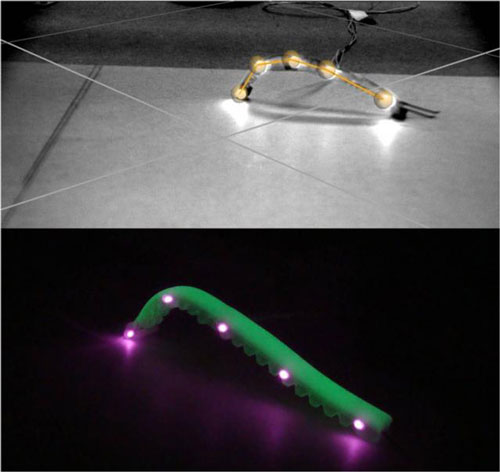| Oct 16, 2012 |
Scientists to research robots of the future
|
|
(Nanowerk News) A five-year grant from the National Science Foundation to Tufts University will help launch an interdisciplinary graduate program to enable scientists and engineers to create soft-bodied robots.
|
|
Inspired by squishy, flexible creatures like the common caterpillar, the researchers from the Schools of Arts and Sciences and Engineering will develop soft-bodied robots that will be continuously deformable and capable of collapsing and crumpling into small volumes. They will have capabilities that are not currently available in conventional robots that are rigid, mechanical machines including climbing textured surfaces and irregular objects, crawling along ropes and wires, or burrowing into complex confined spaces.
|
 |
| Model of a soft-bodied robot with a design inspired by the common caterpillar.
|
|
Tufts has pioneered research into this new generation of robots. Now, with its $2.7 million grant from the NSF's Integrative Graduate Education and Research Traineeship (IGERT) program, Tufts researchers will seek ways to improve upon this new technology. IGERT grants are intended to promote new models in graduate education by supporting collaborative, interdisciplinary research and training.
|
|
The successful proposal to the IGERT grant program was the brainchild of a team that included principal investigator Barry Trimmer, Henry Bromfield Pearson Professor of Natural Sciences in the School of Arts and Sciences Department of Biology, and David Kaplan, professor and chair of the department of biomedical engineering at Tufts School of Engineering and the Stern Family Professor of Engineering.
|
|
The research will engage multiple disciplines by employing novel methods in engineering, computer science,, and tissue engineering.. Tufts faculty members from nine academic departments from the School of Arts and Sciences and the School of Engineering will have a role in teaching the multi-faceted program, which will be open to doctoral students pursuing Ph.D.s in related programs.
|
|
"This is an investment in a range of disciplines that intersect and the goals are to create new technology for soft material robotics," says Trimmer "The special thing here is that researchers, faculty and students will be under one roof."
|
|
Says Kaplan, "By integrating the disciplines, we feel we can get the best of what reach area has to offer to develop soft robotics. Everyone will have a chance to contribute."
|

